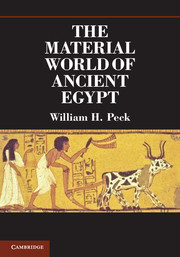Book contents
- Frontmatter
- Contents
- List of Figures
- Preface
- Acknowledgments
- Introduction
- 1 Geography and Geology
- 2 Brief Outline of Egyptian History
- 3 Study of the Material World of Ancient Egypt
- 4 Dress and Personal Adornment
- 5 Housing and Furniture
- 6 Food and Drink
- 7 Hygiene and Medicine
- 8 Containers of Clay and Stone
- 9 Tools and Weapons
- 10 Basketry, Rope, Matting
- 11 Faience and Glass
- 12 Transportation
- 13 Sport and Games
- 14 Music and Dance
- 15 Weapons and Armor
- 16 Conclusions
- Sources of Chapter Heading Quotations
- Bibliography
- Index
3 - Study of the Material World of Ancient Egypt
Published online by Cambridge University Press: 05 August 2013
- Frontmatter
- Contents
- List of Figures
- Preface
- Acknowledgments
- Introduction
- 1 Geography and Geology
- 2 Brief Outline of Egyptian History
- 3 Study of the Material World of Ancient Egypt
- 4 Dress and Personal Adornment
- 5 Housing and Furniture
- 6 Food and Drink
- 7 Hygiene and Medicine
- 8 Containers of Clay and Stone
- 9 Tools and Weapons
- 10 Basketry, Rope, Matting
- 11 Faience and Glass
- 12 Transportation
- 13 Sport and Games
- 14 Music and Dance
- 15 Weapons and Armor
- 16 Conclusions
- Sources of Chapter Heading Quotations
- Bibliography
- Index
Summary
This glimpse into the old world teaches us much.... The progress of civilization, the inventions of mankind have changed but little.
Adolf ErmanThe study of ancient Egypt and ancient Egyptian culture has most often concentrated on the language, history, religion, and prominent monuments. Certainly attention has been paid to the activities of the Egyptians and the objects and processes that made them possible, but not to the same degree. With some rare exceptions archaeologists and historians did not always treat the ordinary tools and utensils with the consideration they deserved. To properly understand the material world in which the Egyptians lived and worked, the emphasis has to be redirected to a certain extent to remedy this. Still, there are bits and pieces of information embedded in histories and narratives that bear reexamination.
It is only natural that those things that made the ancient Egyptians seem different or unusual should command the most attention – pyramids and mummies being the most familiar examples. From the Greek and Roman authors and travelers to the present day, the emphasis, when examining and discussing Egypt, has been to a great extent on the spectacular, the unusual, and the mysterious. Herodotus, writing in the fifth century BCE, went to lengths to describe the country, its geography, and its history as he understood it. He also concerned himself with Egyptian religion and the gods and how they related to the customs and beliefs of the Greeks, but when he came to a discussion of activities and customs, he stressed differences, in part to emphasize some similarities.
- Type
- Chapter
- Information
- The Material World of Ancient Egypt , pp. 34 - 47Publisher: Cambridge University PressPrint publication year: 2013

